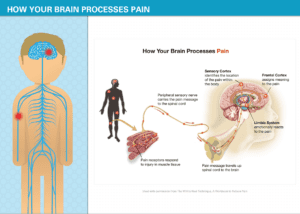Last week was exceptional; I had more patients present to the clinic in tears because of their pain than I can ever remember. We see patients in pain all the time; after all, it is what we treat. However, when the pain overruns a patient’s life, it is always a difficult sight to see. The good news is that most patients usually respond well to treatment and recover within a few weeks. Others may need coaching, guidance and lifestyle changes to help manage the pain, but tend to do well with custom treatment approaches.
Out of all of life’s challenges, pain is probably the most difficult one a person must endure. The region of the brain that processes pain is the limbic system. The limbic system is like a thermostat, modulating how much pain we experience. Some patients may have a more active limbic system, which can cause them to feel more pain than that of a person with a more passive limbic system. This is why some patients are more sensitive to injuries and feel more pain than others.
 Unfortunately, another role of the limbic system is the processing of emotions. Things like context, fear, and anxiety can make a patient’s pain feel worse than it might otherwise be. Back pain is especially severe for this reason; the fear of not knowing the cause of pain can make a patient anxious, resulting in back pain that is worse than it really is.
Unfortunately, another role of the limbic system is the processing of emotions. Things like context, fear, and anxiety can make a patient’s pain feel worse than it might otherwise be. Back pain is especially severe for this reason; the fear of not knowing the cause of pain can make a patient anxious, resulting in back pain that is worse than it really is.
Focusing on the pain can also make it worse. Paying attention to the pain can cause patients to become over-vigilant about their activities, favouring certain movements over natural movements. For example, I had a patient this week who walked more on his left leg to help reduce the pain in his right back. In the short term, this approach can be effective, however, after a few days, this can cause pain in other parts of the body such as the hip and knees.
What can you do to help minimize some of these factors? Distraction has been an excellent way to help manage the symptoms. In fact, distraction has been shown to help patients recover from their pain faster. Whether it be reading a book, going for a walk, or preoccupying yourself with a hobby or activity, distraction is a good way to help the mind focus less on the pain. This can also help patients go back to normal daily activities, which will help improve their recovery time.
Another necessary and effective treatment is movement. Movement helps improve circulation, encourages the body to heal, helps restore motion, reduces the chances of long-term pain and offers many psychological benefits. Nearly all our patients are encouraged to move, as exercise has generally been shown to be the best medicine with pain management.
The good news is most patients do very well and overcome their pain within a short time frame. The first few days are always the most difficult, but I always tell my patients to take it day by day, each day will get better, focus on what you can do, keep moving and following the treatment plan. Usually, within a few days, they are back to about 80% functionality.
Please note, not all the recommendations mentioned above could be right for you. If you are in pain and would like a custom treatment plan to your unique situation, call us for a free consultation at Ph: 905-593-1605.
Write Reviews
Leave a Comment
Lorem ipsum dolor sit amet, consectetur adipiscing elit, sed do eiusmod tempor incididunt ut labore et dolore magna aliqua.
No Comments & Reviews